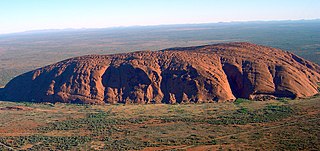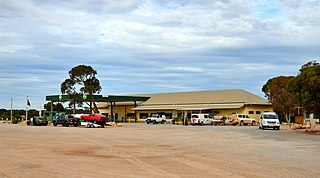
Uluṟu-Kata Tjuṯa National Park is a protected area in the Northern Territory of Australia. The park is home to both Uluru / Ayers Rock and Kata Tjuta / Mount Olga. It is located 1,943 kilometres (1,207 mi) south of Darwin by road and 440 kilometres (270 mi) south-west of Alice Springs along the Stuart and Lasseter Highways. The park covers 1,326 square kilometres (512 sq mi) and includes the features it is named after: Uluru / Ayers Rock and, 40 kilometres (25 mi) to its west, Kata Tjuta / Mount Olga. The location is listed as a UNESCO World Heritage Site for natural and cultural landscape.

Lincoln National Park is a protected area in the Australian state of South Australia located about 249 kilometres (155 mi) west of the state capital of Adelaide and about 9.5 kilometres (5.9 mi) south of the municipal seat of Port Lincoln. It consists of a mainland area on the Jussieu Peninsula on the south eastern tip of Eyre Peninsula and a number of nearby islands. The national park contains significant sites of natural, indigenous and early European heritage.

Boodjamulla National Park, formerly known as Lawn Hill National Park, is a national park in the Shire of Burke, Queensland, Australia. The Riversleigh World Heritage Area is a World Heritage Site within the park.

Uluru, also known as Ayers Rock and officially gazetted as Uluru / Ayers Rock, is a large sandstone formation in the centre of Australia. It is in the southern part of the Northern Territory, 335 km (208 mi) southwest of Alice Springs.

Tourism in Australia is an important part of the Australian economy, and comprises domestic and international visitors. In the financial year 2018/19, tourism was Australia's fourth-largest export and over the previous decade was growing faster than national GDP growth. At the time it represented 3.1% of Australia's GDP contributing A$60.8 billion to the national economy.
Australian art is any art made in or about Australia, or by Australians overseas, from prehistoric times to the present. This includes Aboriginal, Colonial, Landscape, Atelier, early-twentieth-century painters, print makers, photographers, and sculptors influenced by European modernism, Contemporary art. The visual arts have a long history in Australia, with evidence of Aboriginal art dating back at least 30,000 years. Australia has produced many notable artists of both Western and Indigenous Australian schools, including the late-19th-century Heidelberg School plein air painters, the Antipodeans, the Central Australian Hermannsburg School watercolourists, the Western Desert Art Movement and coeval examples of well-known High modernism and Postmodern art.

Circular Quay is a harbour, former working port and now international passenger shipping port, public piazza and tourism precinct, heritage area, and transport node located in Sydney, New South Wales, Australia on the northern edge of the Sydney central business district on Sydney Cove, between Bennelong Point and The Rocks. It is part of the local government area of the City of Sydney.
Michael James Leyland, MBE and Malcolm Rex Leyland, MBE, jointly known as the Leyland brothers, were Australian explorers and documentary filmmakers, best known for their popular television show, Ask the Leyland Brothers, which aired on Australian television between 1976–1980 and 1983–1984. Through their exploits the brothers introduced many Australians to the sights of the Australian outback.

Zetland is an inner suburb of Sydney, New South Wales, Australia 4 kilometres south of the Sydney central business district, in the local government area of the City of Sydney.

Caiguna is a small roadhouse community located on the Eyre Highway in Western Australia. It is the second stop east of Norseman on the journey east across the Nullarbor Plain. Between Balladonia and Caiguna is a 146.6-kilometre (91.1 mi) stretch of the highway which is one of the longest straight stretches of road in the world. The unofficial Central Western Time (CWT) starts at Caiguna heading eastward.

Wonderland Sydney, was an amusement park in Eastern Creek, Sydney, Australia. Officially opened in December 1985 by the Premier of New South Wales, Neville Wran, the park was the largest in the southern hemisphere. It remained open for over 18 years and was the premier theme park in New South Wales for much of its life until its closure in 2004.
The National Folk Festival (NFF) is an Australian family-oriented celebration that has been attended by over 50,000 people.

The Great Central Road is a mostly unsealed Australian outback highway that runs 1,126 km (700 mi) from Laverton, Western Australia to Yulara, Northern Territory. It passes through a number of small communities on the way.

Boro'line Maidstone, previously Maidstone Borough Council Transport was a municipal bus operator in Maidstone and the surrounding villages. Maidstone Borough Council Transport was formed in 1974 from Maidstone Corporation Transport following local government reorganisation. In 1986 Boro'line Maidstone was formed as an arm's length company of Maidstone council from the operations of Maidstone Borough Council Transport. The company had a brief London operation. Following financial difficulties, the London operation was sold to Kentish Bus, and after a period of administration, the assets of the Maidstone operation was sold to Maidstone & District in 1992.

Curtin Springs is a pastoral lease operating as a cattle station in the Alice Springs region of the Northern Territory of Australia.

A substantial car industry was created in Australia in the 20th century through the opening of Australian plants by international manufacturers. The first major carmaker was Ford Australia and the first Australian-designed mass production car was manufactured by Holden in 1948. Australian manufacture of cars rose to a maximum of almost half a million in the 1970s and still exceeded 400,000 in 2004. Australia was best known for the design and production of 'large' sized passenger vehicles. By 2009 total production had fallen to around 175,000 and the Australian market was dominated by cars imported from Asia and Europe.
The 1992 Great Britain Lions tour of Australasia was a tour by the Great Britain national rugby league team, nicknamed the 'Lions', of Papua New Guinea, Australia and New Zealand which took place between May and July 1992. The tour was the last of such length undertaken by the Great Britain team, and included a test match against Papua New Guinea, a three-test series against Australia for The Ashes, and a two-test series against New Zealand for the Baskerville Shield, all interspersed with matches against local club and representative teams.
North Arm Speedway was the first dedicated motorcycle speedway ever built in Adelaide, South Australia and was located in the industrial suburb of Gillman. It was run by the Speedway Riders' Association of South Australia and ran from 1981 until its forced closure in 1997.

The 1988 Rugby League World Cup final was the conclusive game of the 1985–1988 Rugby League World Cup tournament and was played between New Zealand and Australia on 9 October 1988 at Eden Park in Auckland, New Zealand. Australia won the final by 25 points to 12 in front of a New Zealand rugby league record attendance of 47,363. Australia, the defending champions, won the Rugby League World Cup for the 6th time.














